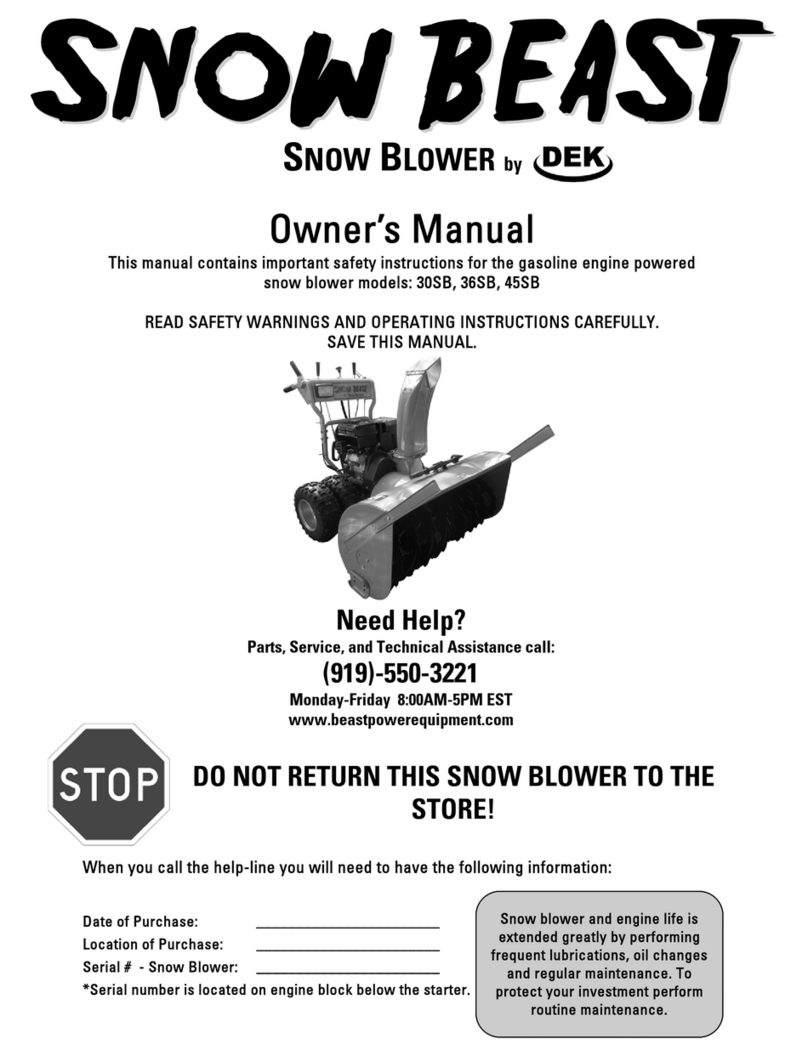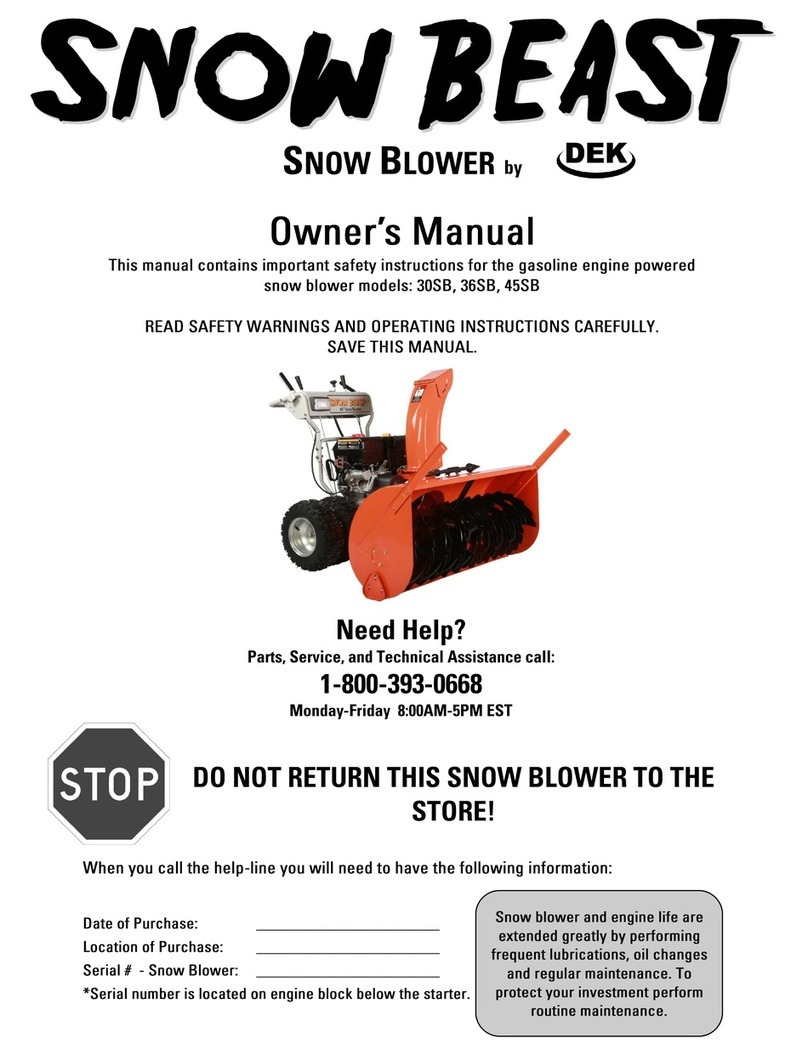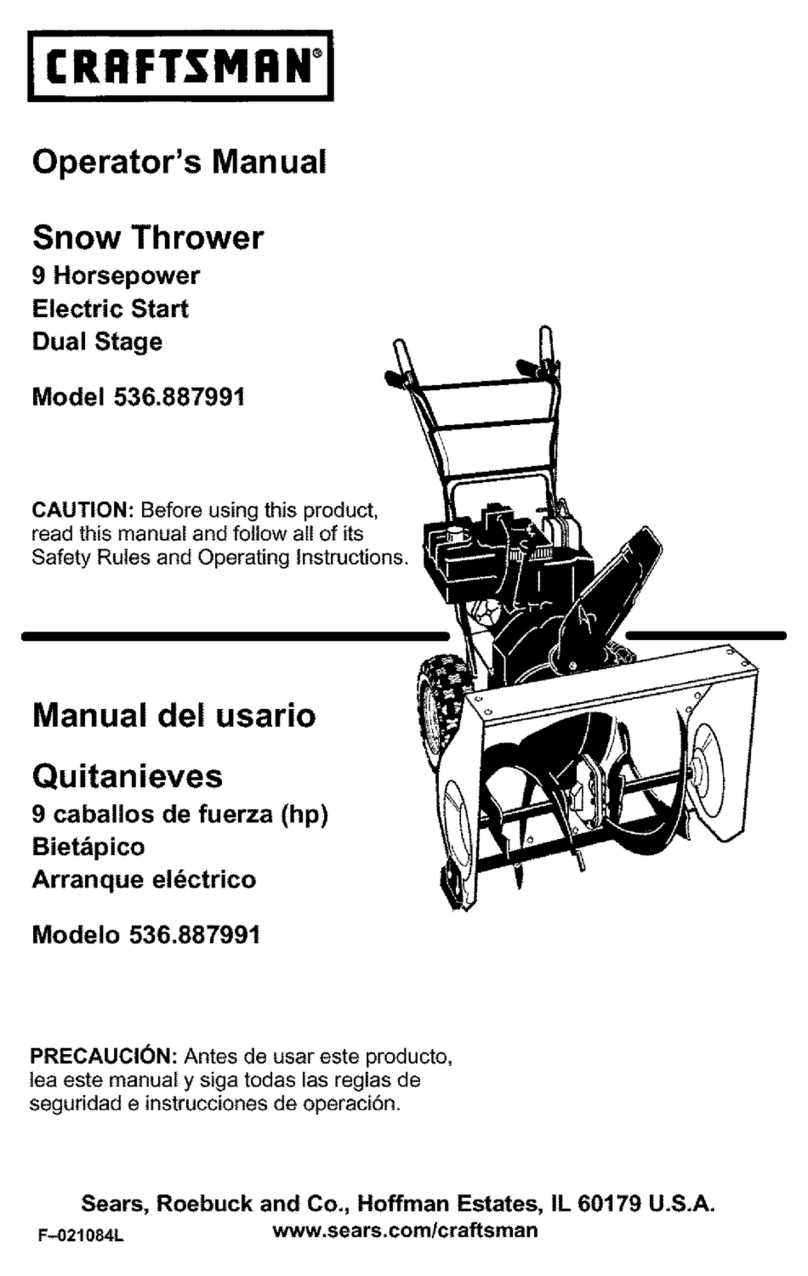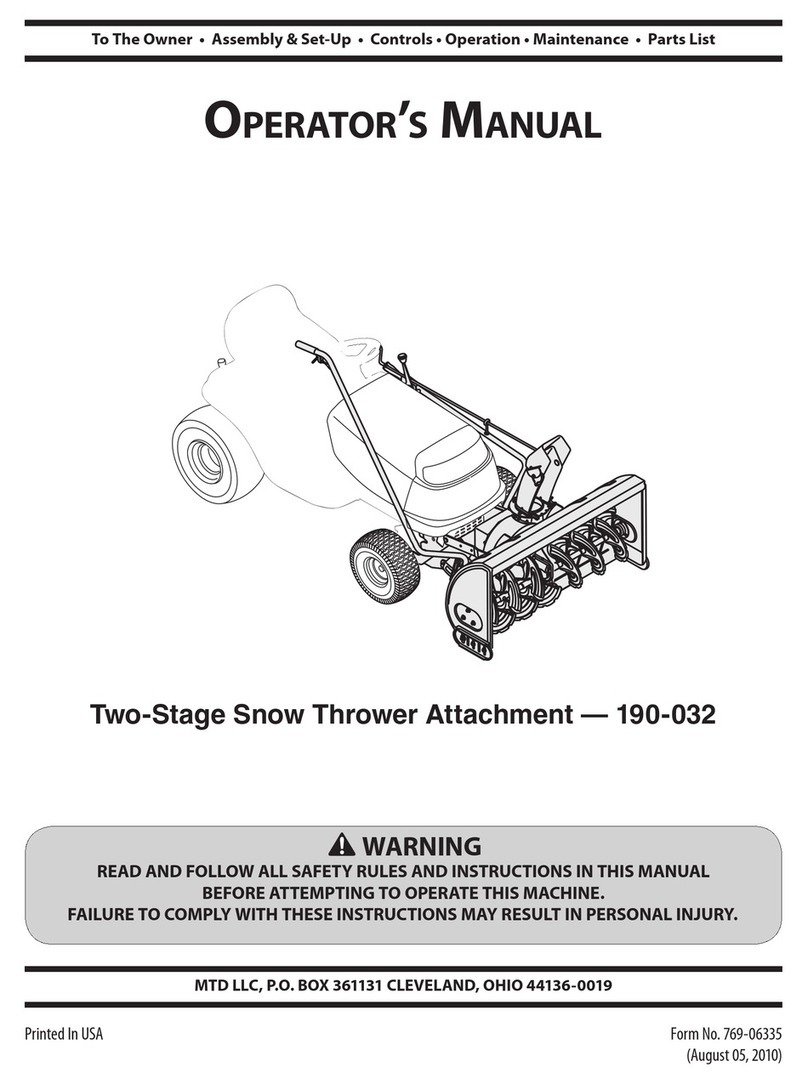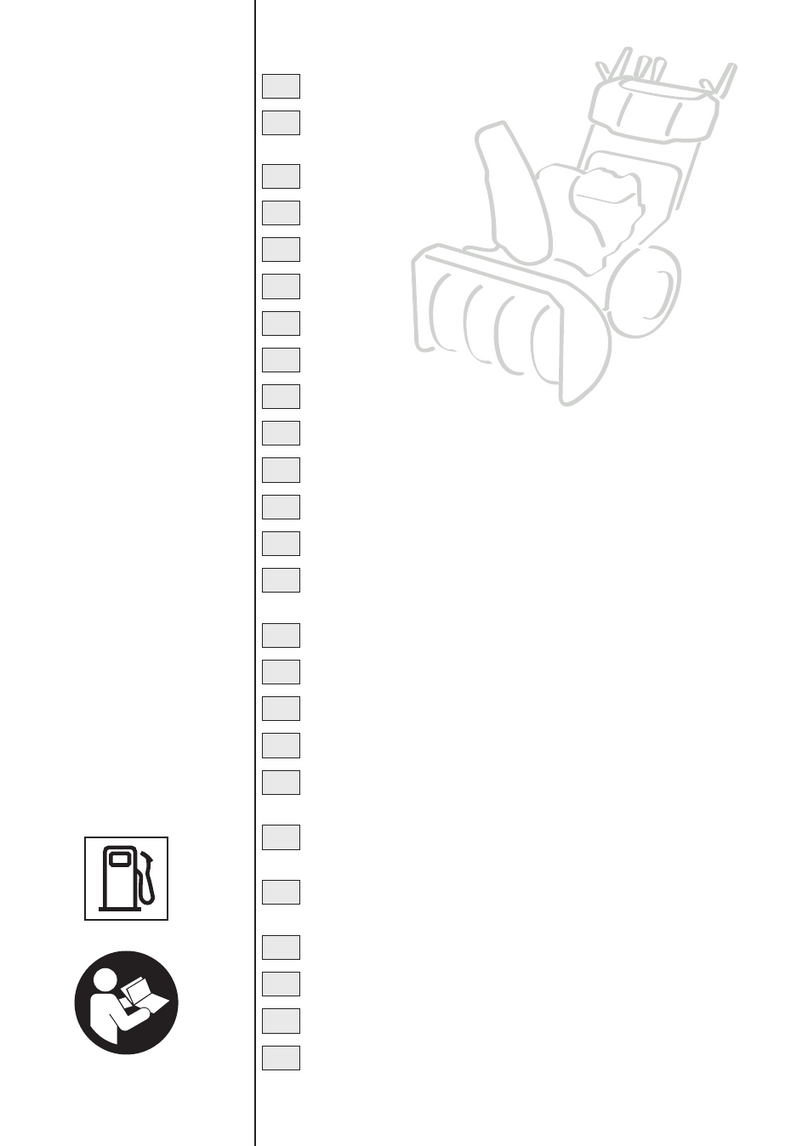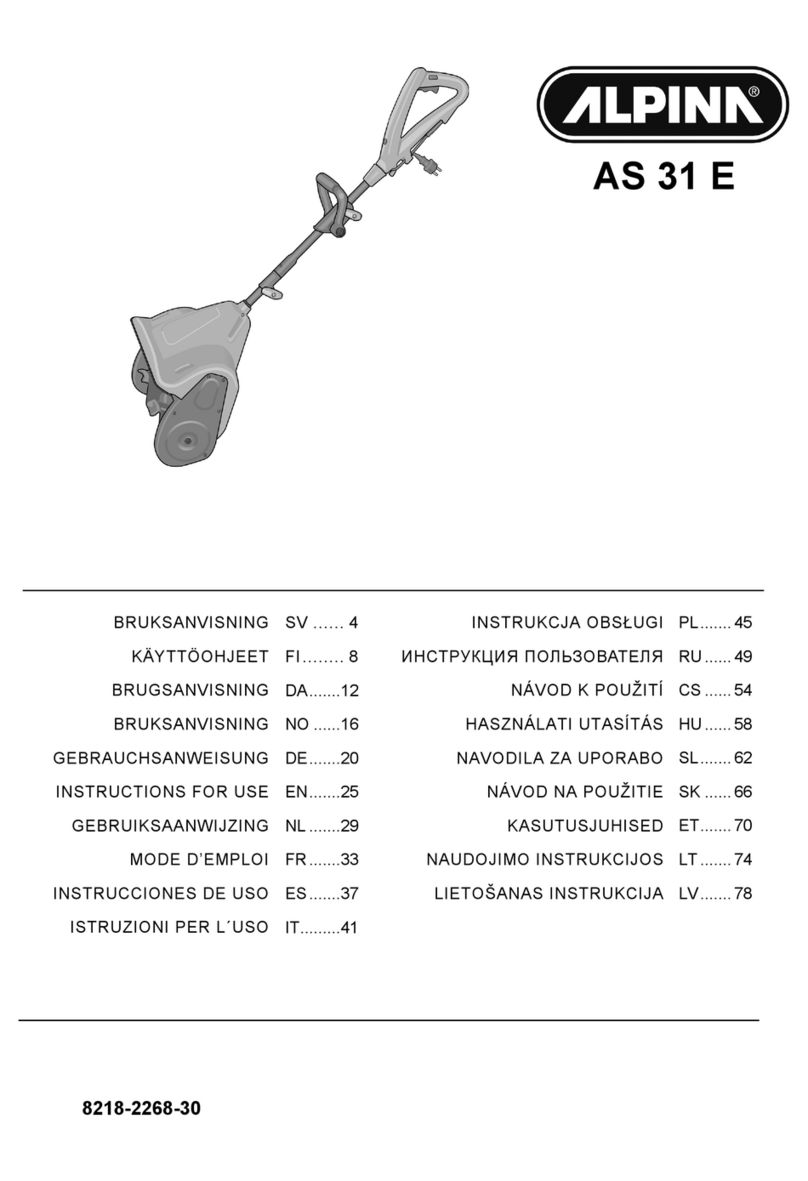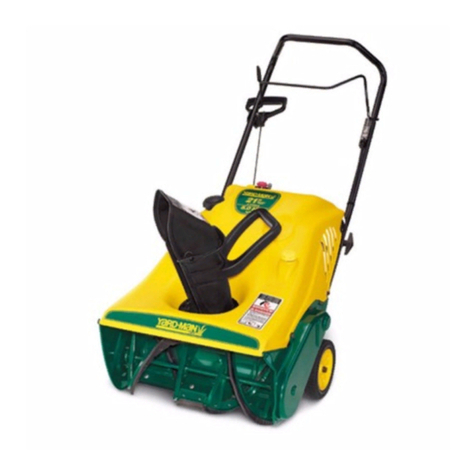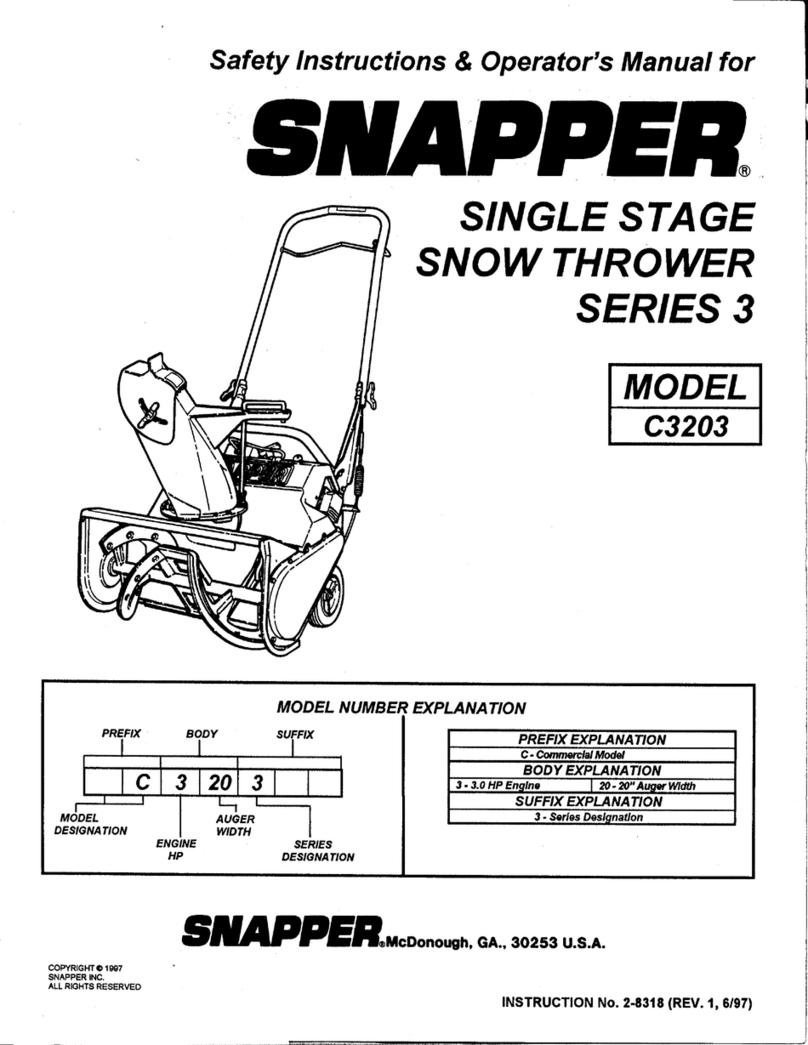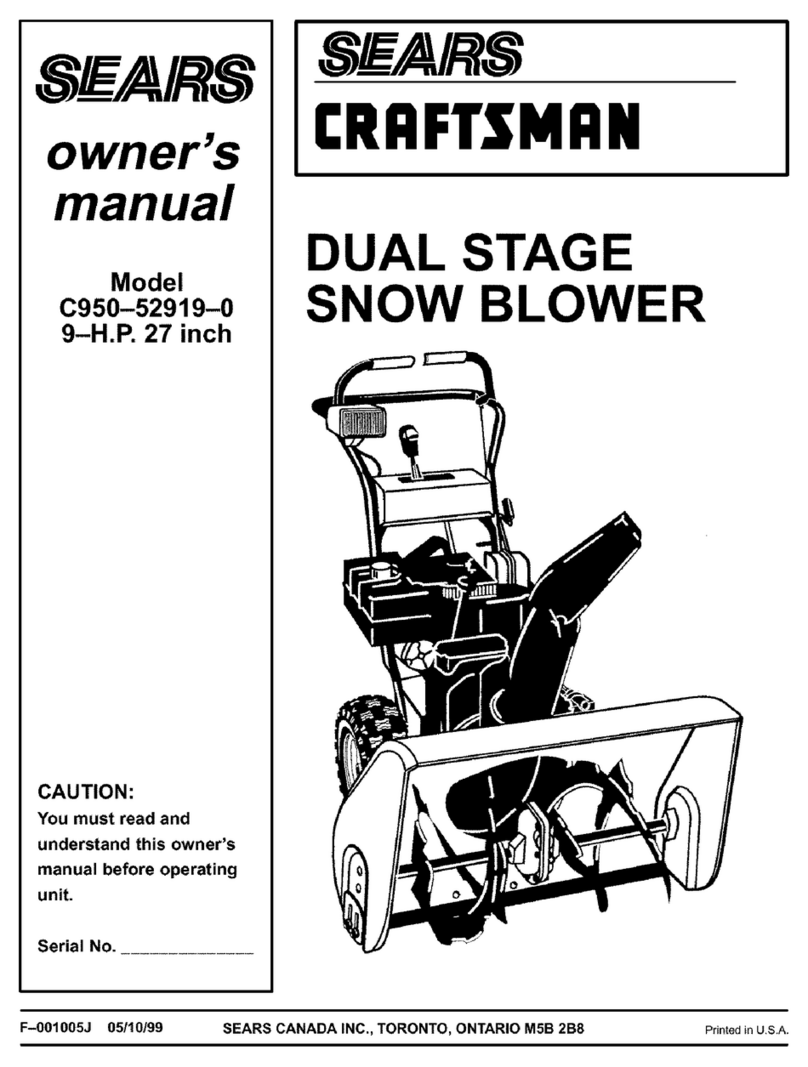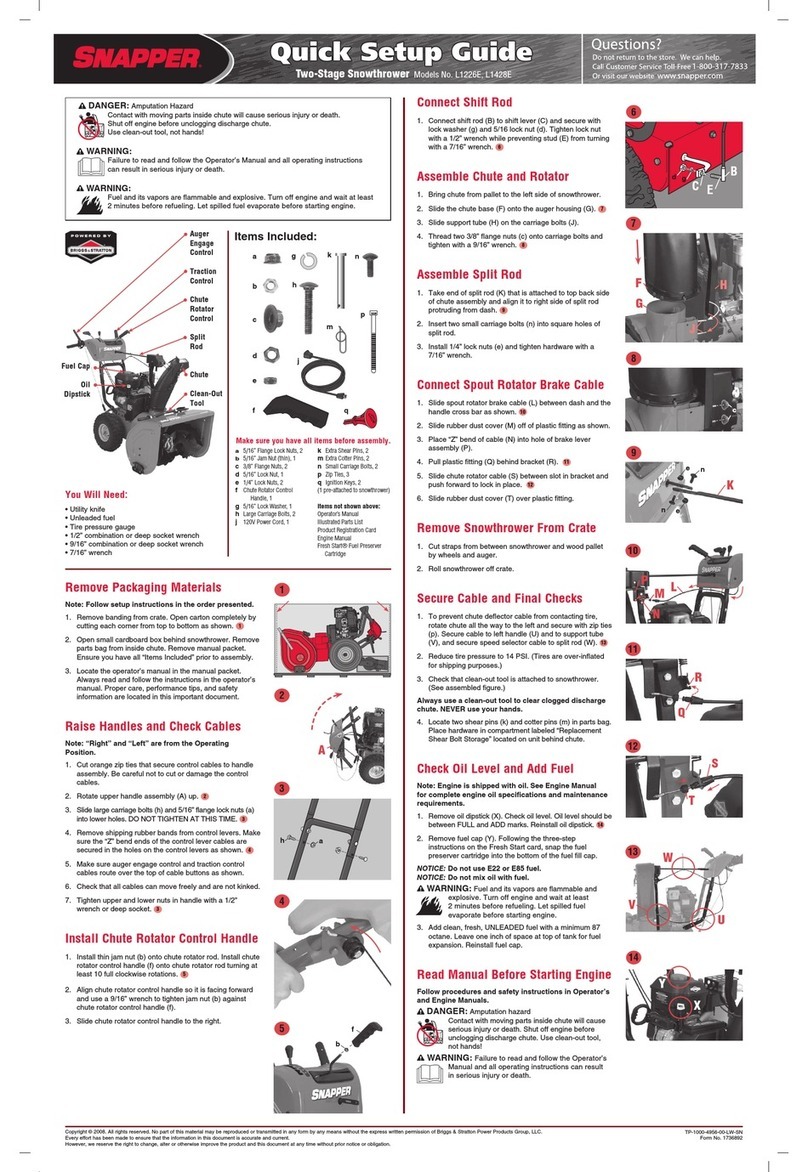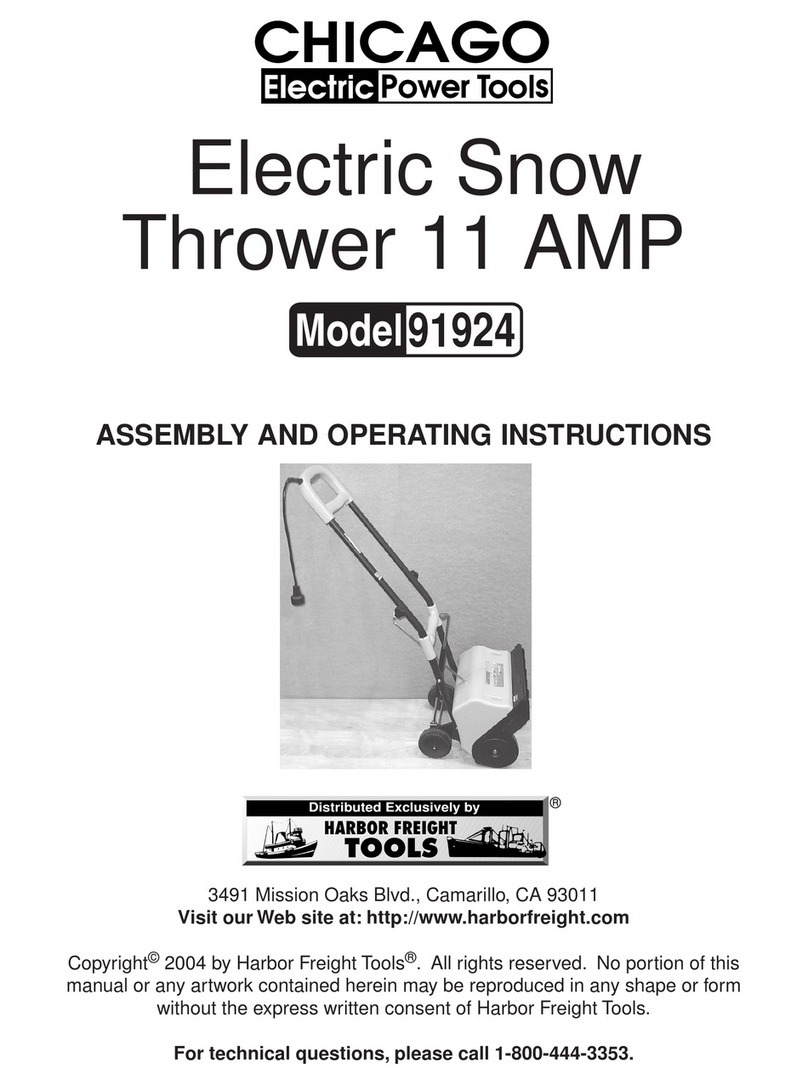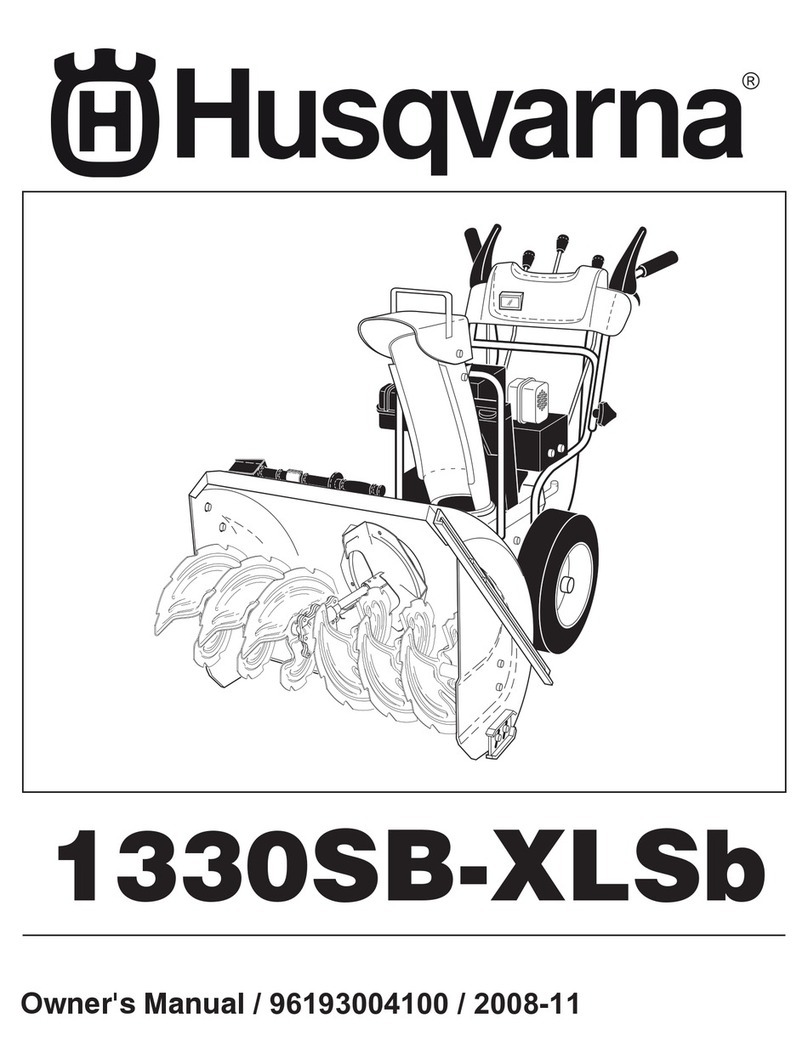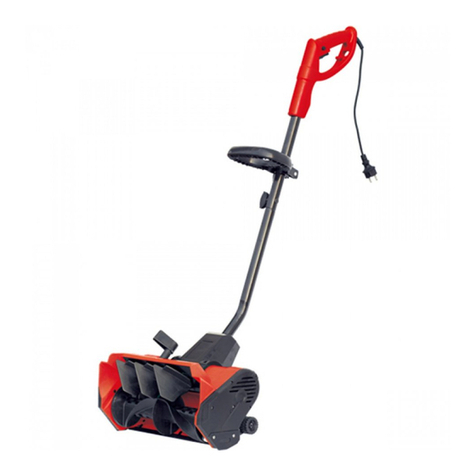DEK 30SD User manual

When you call the help-line you will need to have the following information:
Date of Purchase: _______________________
Location of Purchase: _______________________
Serial # - Snow Blower: _______________________
*Serial number is located on the engine block below the starter.
Snow blower and engine life are
extended greatly by performing
frequent lubrications, oil changes and
regular maintenance. To protect your
investment perform routine
maintenance.
DO NOT RETURN THIS SNOW BLOWER TO THE
STORE!
Need Help?
Parts, Service, and Technical Assistance call:
(919)-550-3259
Monday-Friday 8:00AM-5PM EST
Snow Blower Owner’s Manual
This manual contains important safety instructions for the gasoline engine powered
snow blower models: 30SD, 36SD, 45SD
READ SAFETY WARNINGS AND OPERATING INSTRUCTIONS CAREFULLY.
SAVE THIS MANUAL.

2
30SD, 36SD, 45SD
Rev. Nov2014
This manual contains important safety instructions for Snow Blowers
READ SAFETY WARNINGS AND OPERATING INSTRUCTIONS CAREFULLY
SAVE THESE INSTRUCTIONS.
This owner’s manual is considered a permanent part of the snow blower and should
remain with the snow blower if resold.
Copyright© 2012 by GXi Outdoor Power, LLC. All rights reserved.
No part of this publication can be reproduced or distributed without prior written permission of GXi Outdoor Power, LLC Clayton, NC
27520 USA.
DEK Is a registered trademark of The DEK Works or its affiliates and is used under license by GXi Outdoor Power, LLC, 7868 Highway
70 Business, Clayton, NC 27520
GXi Outdoor Power, LLC reserves the right to discontinue or change specifications or design at any time without notice and without
incurring any obligation whatsoever.
The information and specifications included in this publication were in effect at the time of approval for printing.

3
30SD, 36SD, 45SD
Rev. Nov2014
For more information or where to purchase DEK outdoor power equipment, visit us at:
www.GXiOutdoorPower.com
DEK Product Lines
Brush Mower
36” Brush Mower.
20 hp Kawasaki engine with electric start.
Dual hydrostatic drive for maneuverability.
Convertible deck— easily converts to a finish mower.
Heavy duty 6 gauge welded deck.
High capacity deck for high speeds through tall grass.
Dual break-away blades.
Model #: 36BS
Zero-Turn Commercial Mowers
In three models 48”, 54” and 62”.
Kawasaki engines.
Electric Start.
Roll bar, seat belt, large tires, head lights.
7.5 gallon fuel tank.
Dual hydrostatic drive for maneuverability.
Heavy duty 7 gauge welded steel deck.
Model #: 48ZS
Model #: 54ZS
Model #: 62ZS
100” Tow Behind Mower
Briggs and Stratton electric start engine.
Cuts up to 100 inches.
52 in. main deck, two 26 in. wings folds up
Quick adjust floating deck, no tools required.
High blade tip speeds for cleaner cut.
Converts to a 52’’ brush mower.
Tow behind: ATV, UTV, or lawn tractor.
Model #: 100TS
Commercial Walk Behind Mowers
36” and 54” deck.
20 HP Kawasaki engine with electric start.
4.5 gallon fuel tank.
Dual hydrostatic drive for maneuverability.
Quick change and floating deck type.
Ride along sulky available.
Model #: 36FS
Model #: 54FS

4
30SD, 36SD, 45SD
Rev. Nov2014
DEK Product Lines
Generator Cord Accessories
240V, 10/4, heavy duty extension cords with L14-30 connectors at each end.
This cord reduces harmful voltage drops experienced when using most
120V extension cords
. Available in 15’ and 25’ lengths and can be combined to
reach the desired length.
Electric Pressure Washer
1450 psi to 1800 psi electric pressure washers
20 ft of high pressure hose and 35 ft. cord with GFCI protection
Sleek and unique, high quality, stainless steel finish
13 Amps, 120V
Auto-stop shut off system prolongs pump life
www.gxioutdoorpower.com
Chipper Shredders
Models available from 208cc with 2.25” capacity to 420cc
electric start engines with 3”x4” capacity
Commercial models feature:
- 420cc electric start engine
- Two way feed: 3”x4” capacity limb chute, and over
sized leaf funnel for easy loading
- Hardened steel cutting blade with 16 hammers
- Centrifugal clutch and belt design protect engine and
product from overloading

5
30SD, 36SD, 45SD
Rev. Nov2014
Contents
Safety Information and Warnings......................................................................... 1
Preparation Safety Precautions ............................................................................2
Operation Safety Precautions ................................................................................3
Safety Decals........................................................................................................... 5
Product Specifications ...........................................................................................6
Control Panel and Snow Blower Components.................................................... 7
Missing Parts Request Form...................................................................................8
Assembly Instructions ............................................................................................9
Operating Instructions
Starting the Engine......................................................................................... 14
Operating Instructions....................................................................................15
Avoiding Impeller Freeze-Up.........................................................................19
General Maintenance.....................................................................................20
Maintenance Schedule..................................................................................21
Service Adjustments
Adjusting Augers/Impeller Cable..................................................................22
Adjust/Check Drive Cable ..............................................................................22
Adjusting Shift Rods........................................................................................22
Vertical Service Position................................................................................23
Inspection and Replacement of Transmission Belt...................................24
Inspection and Replacement of Impeller Belt............................................25
Adjusting Discharge Chute Deflector ..........................................................26
Changing Friction Wheel................................................................................26
Replacing Headlight Bulb ..............................................................................26
Transmission System Adjustments ..............................................................27
Storage Instructions ..............................................................................................28
Troubleshooting......................................................................................................29
Replacement Parts.................................................................................................31
About the DEK Snow Blower Manual
Congratulations on the purchase of your new DEK commercial snow blower. We at GXi Outdoor Power are confident that
this snow blower will provide excellent performance, outstanding quality, and great durability when operated and
maintained as directed in this manual.
1. This manual contains assembly, operating, safety, adjustment, maintenance, and troubleshooting instructions.
BEFORE OPERATING YOUR SNOW BLOWER, CAREFULLY READ THIS MANUAL IN ITS ENTIRITY.
2. This owner’s manual is considered a permanent part of the snow blower. It must be available to all operators
and/or person(s) servicing the snow blower. Should the snow blower be resold, this manual must remain with the
snow blower.
3. All information, illustrations, and specifications contained in this manual were in effect at the time of the
publication. GXi Outdoor Power reserves the right to add, delete or modify specifications and/or designs without
notice.
4. If you ever have questions in regards to the operation, maintenance or safety of your snow blower, please

1
30SD, 36SD, 45SD
Rev. Nov2014
Safety Information
Emission Control System Information
The U.S. and California Clean Air Acts
EPA and California regulations require all
manufacturers to furnish written instructions
describing the operation and maintenance of
emission control systems. The following instructions
and procedures must be followed in order to keep
the emissions from your engine within the emission
standards. Maintenance, replacement, or repair of
the emission control devices and systems may be
performed by any engine repair establishment or
individual, using parts that are ‘‘certified’’ to EPA
standards.
Safety Label Locations
Safety labels are located on your snow blower to
warn you of potential hazards. Read them carefully.
If a label comes off or becomes hard to read,
contact GXi Parts and Service, LLC for a
replacement.
Operator Responsibility
It is the owner’s responsibility that all operators and
mechanics must be trained and read this manual
before operating the snow blower as well as being
physically able individuals. They should be
instructed about safe operating and mechanical
procedures. If they can not read or understand
English, it is the owner’s responsibility to explain all
safety operating instructions. The owner or
operator is responsible for accidents or injuries
occurring to themselves, other people or property.
Potential misfortunate incidents can be prevented
Safety Information and Warnings
Snow Blower Inspection
For your safety, inspect the snow blower before each
use. Before you begin your inspection, be sure the
following conditions are met: the snow blower should
be on a level surface, with the ignition switch off, the
key removed, and the augers disengaged. Also,
disconnect the spark plug wires from the spark plugs
and ground them against the engine to prevent
inadvertent starting.
WARNING
WARNING! Do not use your DEK snow blower to carry
passengers. Keep bystanders, helpers, pets and children
at a safe distance from the machine while it is in
operation. Inspect the area where the equipment is to be
used and remove all objects such as rocks, toys, and wires
which can be thrown by the machine causing serious
injury or death.
Wear appropriate clothing including hard hat, safety
glasses and hearing protection. Long hair, loose clothing
or jewelry may get tangled in moving parts.
WARNING
Training
1. Read, understand, and follow all instructions on the
machine and manual(s) before attempting to
assemble and operate.
2. Operator must be familiar with all controls, their
operations, and how to stop the engine and
disengage the controls quickly.
3. Never allow children to operate this machine.
4. Never allow adults to operate this machine without
proper instruction.
5. Exercise caution to avoid slipping or falling,
especially when operating the machine in reverse.
6. Keep area of operation clear at all times.

2
30SD, 36SD, 45SD
Rev. Nov2014
Preparation Safety Precautions
Preparation—Safety Precautions
1. Inspect the area where the equipment is to be
used and remove all objects such as rocks,
mats, and wire which can be thrown by the
machine causing serious injury or death.
2. Disengage all clutches and shift to neutral
before starting the engine.
3. Disengage all control levers before starting the
engine.
4. Use extension cords and receptacles as
specified by the manufacturer for all units with
electric drive motors or electric starting
motors.
5. Use a grounded three-wire extension cord
when using the electric start option.
6. People, pets, and most importantly children
must not be near the area being cleared. Do
not operate the snow blower in their presence.
7. Never operate snow blower with damaged
guards, shields or covers.
8. All users of the snow blower must be alert and
pay attention to safety alerts, symbols, and
safety signs.
9. Be sure to inspect snow blower before each
use.
10. Check the controls and shields to make sure
that they are functioning properly before
operating. Do not operate if any are damaged
or missing.
11. Never attempt to make any adjustments to the
snow blower while it is running.
12. Adjust the collector housing height to clear
gravel or crushed rock surfaces.
13. Wear appropriate clothing including hard hat,
safety glasses and hearing protection. Long
hair, loose clothing or jewelry may get tangled
in moving parts.
14. Do not operate without wearing adequate
winter clothing. Wear footwear that will
improve footing on slippery surfaces.
15. Allow snow blower to adjust to outdoor
temperature before starting the engine.
DANGER: GASOLINE IS HIGHLY FLAMMABLE AND
EXPLOSIVE. Do not add fuel while the engine is
running or is hot. Keep open flames, sparks, and heat
away from the fuel and store fuel in containers
specifically designed for that purpose. ADD FUEL
OUTDOORS ONLY. IF THE FUEL IS SPILLED, DO NOT
START THE ENGINE. Manually push the snow blower
away from the spill and wipe up immediately.
DANGER
Gasoline and other fuels—Safety Precautions
Use extra care when handling gasoline and other
fuels as they are flammable and vapors can explode.
1. Only use gasoline approved containers for storage
and keep out of reach from children.
2. Do not fill fuel tank completely full. Overfilling may
result in fuel leakage. Leave a reasonable amount
of space for fuel to expand.
3. If fuel is spilled, do not start the engine. Move the
snow blower away from the area, wipe up the spill
thoroughly and wait until fuel vapors have
evaporated before starting engine.
4. Keep the nozzle in contact with the rim on the fuel
tank or container opening at all times, until
refueling is complete. Do not use nozzle lock-open
device.
5. Do not fill gasoline containers or equipment inside a
vehicle or on a truck/trailer bed.
6. Always place gasoline containers on the ground
away from your vehicles prior to filling.
7. Never remove gas cap or add fuel when engine is
running or the engine is hot.
8. Avoid prolonged breathing of gasoline vapors.
9. Never refuel or drain the machine indoors.
10. Keep face away from nozzle and gas tank opening.
11. Keep gas and other fuels away from skin and eyes.
If fuel is spilled on clothing, change clothing
immediately.
12. Never use the mouth to siphon gas.
13. Never refuel the snow blower until all moving
parts on the snow blower have stopped.
14. Never smoke when handling fuels and stay away
from an open flame where fumes can be ignited by
a spark.

3
30SD, 36SD, 45SD
Rev. Nov2014
Operation Safety Precautions
Equipment Operation—Safety Precautions
1. Do not operate the engine in a confined space
where dangerous carbon monoxide fumes can
collect. Carbon monoxide is odorless,
tasteless, and can be fatal.
2. Never operate the snow blower without good
visibility or light.
3. Exercise extreme caution when operating on
or crossing gravel drives, walks, or roads. Stay
alert for hidden hazards or traffic.
4. Never operate the snow blower with defective
guards or shields, or without the safety devices
securely mounted in place and functioning
properly.
5. Be aware of discharge and never direct
discharge of material toward people or areas
where property damage can occur. Keep
children and others away.
6. Do not change the governor settings or over
speed the engine.
7. Do not overload the machine capacity by
attempting to clear snow at too fast a rate.
8. Always stop the engine when you leave the
snow blower, even for a moment.
9. To help reduce fire hazard, keep the engine
and the area around the engine free of grass,
leaves or any other type of foreign material.
10. Beware of any sharp edges. For safety always
wear gloves when performing augers/impeller
maintenance activities
11. If lightning is seen or thunder is heard in the
operators vicinity, do not operate machine.
Instead find shelter, as lightning may cause
injury/death.
12. After striking a foreign object, stop the engine,
remove the wire from the spark plug,
thoroughly inspect the snow blower for any
damage, and repair the damage before
restarting and operating the snow blower.
13. If machine starts to vibrate or function
abnormally, stop the engine immediately and
check for cause. Vibration is generally a
warning of trouble.
14. Keep hands and feet away from augers/
impeller . This product is capable of amputating
hands and feet.
15. Be alert and slow down when making turns.
Also look left, right, and behind before changing
directions and reversing to be sure there is a
clear path.
16. Never operate snow blower at high transport
speeds on slippery surfaces.
17. Never operate snow blower under the influence
of alcohol and drugs.
18. Use care when loading or unloading the
machine into a trailer or truck.
19. Use care when approaching blind corners,
shrubs, trees, or other objects that may
obstruct vision.
20. Always disengage power to augers when not in
use or transported.
21. Never listen to music with headphones/
earphones while operating the snow blower.
22. Use extreme caution when operating on slopes.
23. Never touch a hot engine or muffler.
24. Use caution when operating on gravel surfaces.
25. Only use attachments and accessories that are
approved by DEK.
26. When starting the engine pull the cord slowly
until some resistance is felt before using full
force.
27. Always have a good grip on the handles and
never run while operating the snow blower.
28. Stop the engine whenever you leave the
operating position, before unclogging the
augers/impeller or discharge chute, and when
making any repairs, adjustments or inspections.
29. When cleaning, repairing or inspecting the
snow blower, stop the engine and make certain
the augers/impeller and all moving parts have
stopped. Disconnect the spark plug wire and
keep the wire away from the plug to prevent
someone from accidentally starting the engine.

4
30SD, 36SD, 45SD
Rev. Nov2014
Operation Safety Precautions
Before attempting to use your snow blower,
make sure you are familiar with all of the
components and have read the manual.
Need Help?
Parts, Service
and Technical Assistance call:
(919)-550-3259
Monday-Friday 8AM-5PM EST
www.gxioutdoorpower.com
DANGER: Do not bypass, modify, alter or
disconnect the safety system. Make sure
that the safety interlock system is fully
operational each time before operating the
machine.
Before setting up your DEK snow blower,
disconnect the spark plug wires from the
spark plugs and ground them against the
engine to prevent inadvertent starting. This
step should be taken as a precaution
whenever you are working on this machine.
IMPORTANT! The snow blower belts are adjusted
to ensure the augers/impeller stop turning within
five (5) seconds of releasing the impeller control
lever. If you are making any belt adjustments
whatsoever, for your safety and the safety of others
around you, you must ensure the belts are re-
adjusted to achieve this design specification.
GASOLINE IS HIGHLY FLAMMABLE AND
EXPLOSIVE. FUEL LEAKS, A LOOSE FUEL TANK,
OR A LOOSE FUEL VALVE CAN LEAD TO
SEVERE INJURY OR DEATH. DO NOT OPERATE
THIS SNOW BLOWER IF ANY COMPONENT OF
THE FUEL SYSTEM IS LOOSE OR LEAKS
GASOLINE!
Clearing A Clogged Chute—Safety Precautions
1. SHUT THE ENGINE OFF!
2. Wait at least 10 seconds to be sure the augers have
stopped rotating.
3. Remove and ground the spark plug when clearing
the blockage.
4. Always use a cleanout tool and never your hands.
Check engine oil level before each use.
Maintain oil level between run marks on the
dipstick, and change oil according to the
Do NOT over-prime the engine. Pressing the
primer bulb more than 3x could result in flooding
the carburetor making the engine hard to start

5
30SD, 36SD, 45SD
Rev. Nov2014
Safety Decals
Safety Decal Identification
The labels shown below are located on your snow blower to warn you of potential hazards and provide you with
important safety information. If these decals become difficult to read or are missing from the snow blower, please
contact GXi Parts & Service, LLC at 1-919-550-3259 or www.gxioutdoorpower.com for a replacement.

6
30SD, 36SD, 45SD
Rev. Nov2014
Product Specifications
* Product Specifications may
change without notice.
Feature 30S
S
36S
S
45SS
Product Type Snowblower Snow blowe
r
Snow blower
Clearing Path 30? 36? 45?
Engine 302c
c
420cc 420cc
Torque 15.9 ft .lbs 20.7 ft.lbs 20.7 ft.lbs
Engine Start 120V Electric Start and recoil 120VElectric Start and Recoil 120V Electric Start and Recoil
Speed Control 6 fwd, 2 re
v
6 fwd, 2 re
v
6 fwd, 2 re
v
Deck Type All Steel All Steel All Steel
Discharge distance 40? 40? 40?
Impelle
r
16? 2 Stage 16? 2 Stage 16? 2 Stage
Auger 16? serrated 16? serrated 16? serrated
Discharge Chute 6? 6? 6?
Fuel/Capacity Unleaded gasoline/1.32 GAL Unleaded gasoline/1.32 GAL Unleaded gasoline/1.32 GAL
Chute control Cran
k
Cran
k
Crank
Model
s
30SD 36SD 45SD

7
30SD, 36SD, 45SD
Rev. Nov2014
Control Panel and Snow Blower Components
Discharge Chute
Drift Cutters
Collectors/Impeller
Adjustable
Skid Shoes
Belt Cover
Muffler—HOT!
Safety Key
Choke
Discharge Deflector
Control Panel
Handle Bar
Headlight
Snow Blower Component Identification
(Some components may appear different than shown, depending on the model.)
Discharge Angle
Control
Transmission
Discharge
Chute Direction Headlight
Switch
Transmission
Speed Control
Primer
Do NOT Over-Prime
Serial #
Stamped on Engine
Impeller / Collector
Throughout this manual, instructions are given on the operation of your DEK snow blower. We recommend that while going through this
manual, you have your snow blower available for quick and easy access in order to orient yourself with the controls, maintenance and
orientation of different parts. Please read through the manual before operating.
Control Panel
Below is a diagram of the control panel. Please take the time to familiarize yourself with the snow blower controls.
Cleanout Tool

8
30SD, 36SD, 45SD
Rev. Nov2014
Missing Parts Request Form
Name
Phone
Email
Address
IMPORTANT: Please include your receipt. Without a receipt, your
order will be delayed. You may also email us at:
customerservice@gxioutdoorpower.com
Fax: (919)-550-3277
If emailing, please scan in your proof of purchase.
Please refer to pages 26-30 for a detailed parts listing and description. This will
expedite the process of getting parts identified correctly for shipment.
Comments:
Please indicate the part that you are missing:
Hardware bag
Model #:
Other
Serial #:
Date of purchase

9
30SD, 36SD, 45SD
Rev. Nov2014
Assembly Instructions
Step 1: Control Panel Handles
1. Align the two holes on each side of the control panel
handles over the lower handle frame.
2. Insert the bolts through the handlebar holes and frame
holes. Secure in place with hardware provided. Insert
bolts from the inside.
Step 3: Chute Rotation Cable
Attach the cable coming from the middle of the
control panel by screwing the cable end onto the
crank section.
See next page for specific instructions regarding
this assembly.
Need Help With Assembly?
1-919-550-3259
Step 2: Directional Discharge Chute
1. Fit the black plastic round spacer onto impeller housing
before installing chute. Apply light coat of grease onto
spacer.
2. Install the bolts for the retainer brackets with the plastic
spacer between the chute and the steel retaining tabs.
DO NOT OVERTIGHTEN. If the bracket is too tight the chute
will not move properly. Ensure there is enough space
between the impeller housing and the bracket on all sides
so that the chute rotates smoothly.

10
30SD, 36SD, 45SD
Rev. Nov2014
1. Locate the connection: The chute rotation cable connection is located at
the base of the discharge chute between the engine and the discharge chute.
2. Slide the threaded end of the connector down the
cable in order to easily see the end of the cable con-
nection. The center section should be about 3/4” to
1” beyond the end of the cable.
NOTE: There is nothing wrong if the end of the cen-
ter section of the cable protrudes more than about
3/4” to 1” beyond the end of the cable.
The center section can be easily pushed back into
the cable.
3. Align the center section with the cable chute rotator. The end
of the center section is square and requires proper alignment in
order to correctly connect to the machine.
4. Press the cable toward the chute rotator screw. The end of the
cable should touch the end of the chute rotator.
If the surfaces do not contact, continue to apply pressure and
slowly rotate the discharge chute direction handle on the control
panel so the center of the cable aligns itself on both ends.
5. Slide the threaded end from Step 2 toward the chute rotator,
and thread the end onto the chute rotator.
IMPORTANT: Finger tighten firmly. Inspect before each use to make certain
the connection doesn’t loosen during operation of the machine.
Step 3: Chute Rotation Cable (continued)
Assembly Instructions
Need Help With Assembly?
(919)-550-3259

11
30SD, 36SD, 45SD
Rev. Nov2014
Step 4: Chute Direction Control Cable Support
With the rubber lined strap removed, put the chute
direction control cable and the chute deflector
cable into the opening, and press the strap
together aligning the hole for the bolt.
Secure strap to side of the engine.
NOTE: Rotate discharge chute and ensure there is
no binding of any cables and there is enough slack
in the deflector cable for full rotation.
Need Help With Assembly?
(919)-550-3259
Step 5: Drift Cutters (if desired)
1. The drift cutters are attached to the main housing in
the stored position.
2. Remove the two bolts on each drift cutter.
3. Reattach the drift cutters in the operating position.
4. Replace bolts and secure tightly.
Step 6: Skid Shoes
1. Skid shoes are stored in the hardware bag for shipping.
2. Remove from hardware bag, and install skid shoes using the provided
fasteners
3. Insert the fasteners so the flat head of the carriage bolt is toward the
inside of the main housing.
CAUTION: Check the skids to ensure that the auger does not
contact the paved or gravel surface. Adjust skids as necessary to
make up for wear on the snow blower.
Position skid shoes so that the scraper blade is elevated at least
1/4” from the ground. This allows easier maneuvering and
prevents drag on the snow blower when encountering unseen
imperfections on the surface to be cleaned.
1. Check the tire pressure to ensure the tires are properly inflated.
2. Move skid shoes up and down to the desired position based on the
surface texture.
If the surface is rougher adjust the skid shoes lower which increases
the auger ground clearance.
If the surfaces is smoother adjust the skid shoes higher (decrease
ground clearance). Firmly tighten the nuts that secure both skids to
the auger sides.

12
30SD, 36SD, 45SD
Rev. Nov2014
Assembly Instructions
Step 7: Auger and Transmission Control Cables
Control cables are preset at the factory, but may require additional adjustment for optimal operation. Control cables
require periodic inspection and maintenance to maintain optimal performance.
1. Locate the black cable on the right side (standing from the operator position) of the snow blower. Ensure the
cable is properly seated in the plastic guide pulley at the rear of the chassis.
2. Attach the cable to the threaded end under the drive control handle. The cable adjustment tube with Z rod may
need to be attached to the bottom of the handle.
3. Screw clockwise to secure until all threads are engaged in the adjustment tube. Tighten lock nuts when correct
tension is achieved.
4. The drive and impeller cables will be at correct tension when the cables are properly attached to the handles and
the cable has a 1 inch deflection to either side when pushed with a finger as shown.
Correct amount of
deflection shown
Need Help With Assembly?
(919)-550-3259
Transmission
Control Cable
Auger/Impeller
Control Cable

13
30SD, 36SD, 45SD
Rev. Nov2014
High Mark
Step 10: Filling Oil and Gasoline
1. Fill the engine with SAE 5W-30 engine oil. Fill the engine with 1.2 to 1.5 quarts of oil. Fill up to the full level mark on the dip
stick. Do not overfill.
When checking oil, remove dipstick, wipe completely clean, insert dipstick into dipstick tube on the engine (do NOT screw
dipstick down), remove dipstick and observe oil level (detail below).
Keep oil level at the high run mark for longest engine life.
2. Check that the fuel inlet screen is clean and fill the tank to the proper level leaving adequate space for fuel to expand when the
engine is running at its operating temperature. That level is about 0.75-1” below the top of the tank to ensure no gasoline leaks.
DANGER: GASOLINE IS HIGHLY FLAMMABLE AND
EXPLOSIVE. Do not add fuel while the engine is
running or is hot. Keep open flames, sparks, and heat
away from the fuel and store fuel in containers
specifically designed for that purpose. ADD FUEL
OUTDOORS ONLY. IF THE FUEL IS SPILLED, DO NOT
START THE ENGINE. Manually push the snow blower
away from the spill and wipe up immediately.
DANGER
Step 9: Headlight
1. Connect snow blower headlight wire plug to the headlight
bulb.
2. Connect the headlight bezel to the control panel.
A. Tilt headlight assembly and align tabs on the top
of the headlight bezel with the notches in the
control panel. Insert the notches into the panel.
B. Tilt headlight assembly down while gently
squeezing the headlight bezel and push headlight
into control panel.
Assembly Instructions
Need Help With Assembly?
(919)-550-3259
GASOLINE IS HIGHLY FLAMMABLE AND
EXPLOSIVE. FUEL LEAKS, A LOOSE FUEL TANK,
OR A LOOSE FUEL VALVE CAN LEAD TO
SEVERE INJURY OR DEATH. DO NOT OPERATE
THIS SNOW BLOWER IF ANY COMPONENT OF
THE FUEL SYSTEM IS LOOSE OR LEAKS
GASOLINE!
Check engine oil level before each use.
Maintain oil level between run marks on the
dipstick, and change oil according to the
Low Mark

14
30SD, 36SD, 45SD
Rev. Nov2014
Starting the Engine
DANGER: Exhaust contains poisonous carbon
monoxide, a colorless and odorless gas. Breathing
exhaust can cause loss of consciousness and may
lead to death. Do not operate the engine in a
confined space where dangerous carbon monoxide
fumes can collect.
Starting the Engine Using the Recoil Start
NOTE: Be sure to add fresh unleaded gasoline and leave
a gap for expansion and fill the engine with SAE5-W30
motor oil (1.2—1.5 quarts) before starting your snow
blower. Check engine oil before each use.
1. Make sure the safety key is fully inserted in order for
the engine to start. Remove the key when the snow
blower is not in use.
2. Firmly push the primer to force the fuel directly into
the engine’s carburetor. Push two to three times
depending on the temperature. Note: Do not press
the primer bulb more than 5 times. Fuel may leak
from the carburetor with over priming.
3. Make sure the choke is set in the CHOKE 1 position
(choke more in colder temperatures).
4. Pull the recoil to start the engine.
5. After the engine is started, slowly turn the choke up
one level at a time as the engine warms up until it is
at the maximum level or “RUN LEVEL.”
Before attempting to use your snow blower, make sure you
are familiar with all of the components and have read the
manual.
DANGER
Starting the Engine using the
Electric Start
1. Use a safe, non damaged power
cord to plug into the electric start outlet.
2. Make sure the safety key is fully inserted in order for
the engine to start. Remove the key when the snow
blower is not in use.
3. Firmly push the primer to force the fuel directly into
the engine’s carburetor. Push two to three times
depending on the temperature. Note: Do not press
the primer bulb more than 5 times. Fuel may leak
from the carburetor with over priming.
4. Make sure the choke is set in the CHOKE position
(choke more in colder temperatures).
5. Press the electric start button. Note: Do not engage
starter more than 10 seconds each time.
6. After the engine is started, slowly turn the choke up
one level at a time as the engine warms up until it is
at the maximum level or “RUN LEVEL.”
7. Unplug the extension cord before operating the
Thoroughly inspect the area where you plan to use the
snow blower. Look for items such as stones, sticks ,
wire, and other foreign objects. If struck by the snow
blower, these and other objects may become
projectiles that could lead to serious injury or death.
Clear area of all debris. Keep people and pets at a safe
distance.
WARNING
WARNING
WARNING! The electric starter is designed to
operate on 120 volt AC household current. Use only a
UL-listed, 16 gauge extension cord for outdoor use that is
no longer than 50 feet (15 meters).
To prevent damaging the electric
starter wait 20 seconds between
every electric start attempt and
never use electric start in the rain.
Do NOT over-prime the engine. Pressing the
primer bulb more than 3x could result in flooding
the carburetor making the engine hard to start
Safety Key
Choke
Primer
Do NOT
Over-Prime

15
30SD, 36SD, 45SD
Rev. Nov2014
Operating Instructions
Transmission Control
Your snow blower is equipped with an easily
adjustable transmission control, which can be
adjusted for forward and reverse speed.
There are six forward and two reverse speeds.
To change the speed, pull the handle out to the right
and move the handle to the desired speed.
IMPORTANT! The snow blower belts are adjusted to ensure the augers stop turning within five (5) seconds of
releasing the impeller control lever. If you are making any belt adjustments whatsoever, for your safety and the safety
of others around you, you must ensure the belts are re-adjusted to achieve this design specification.
To Stop Engine
To stop the engine, pull the safety key up until the engine
and augers/impeller stops running. For safety, it is
recommended that you remove the key when not using the
snow blower.
WARNING
WARNING! Do not operate the snow blower
with defective guards, shields, or without the
safety devices securely in place.
Engage Transmission Drive
To engage the transmission drive squeeze the right lever to
the hand grip.
To disengage, let go of the right lever.
Engage Augers/Impeller Control
To engage the augers/impeller drive, squeeze the left
lever to the handgrip.
To disengage release the left lever.
DO NOT shift speeds while
the transmission is engaged.
Come to a complete stop and
disengage the transmission
handle before changing
speed or switching from
forward to reverse.
WARNING
This manual suits for next models
2
Table of contents
Other DEK Snow Blower manuals

